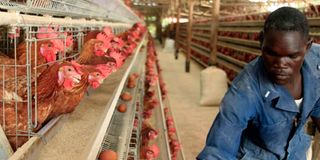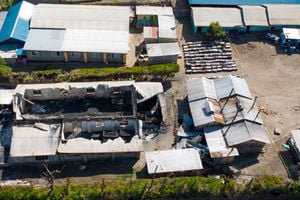Why caged birds suffer paralysis

Birds kept under the cage system. With rise in demand for chicken meat and eggs, most farmers have embraced the cages.
There has been a lot of debate recently on the welfare of livestock reared under what is termed as factory farming. This is a system of rearing livestock like poultry, pigs, cattle, sheep and goats using highly intensive methods. The animals are confined in shelters under strictly controlled conditions.
Factory farming has been necessitated by the rapidly increasing demand for meat, milk and eggs to provide humans with sufficient protein of animal origin. It is now conventionally agreed that these types of food contribute greatly to human nutrition, health and food security.
The increasing human population globally has also resulted in great reduction in the land available for livestock production. In addition, there is a lot of awareness in business farming. Farmers need to make profits from their investments.
One of the most common methods of factory farming is cage farming of layer chickens. The birds are housed in threes in wire cages. The cages are stack up to the level that a person can feed the birds and collect eggs while standing. In advanced factory farms, temperature control, feeding, watering, egg collection and manure removal are all automated.
Cage layer farming has several advantages, including being highly efficient for utilisation of space. The birds also produce more because they spend minimal amount of energy resources in movement. Third, there is better disease-prevention and control because all the droppings fall to the floor, thus, the birds have very little contact with each other and no contact with other animals.
Despite the benefits of cage layer farming, animal welfare advocates have been pushing for abolition of the system. They cite the strict movement restriction of the birds because they only have sufficient space to turn around in the cage. The animal welfare advocates argue that the restriction violates the birds’ freedom to express normal behaviour.
Birds in cages are not able to jump around, make attempts at flying or playfully run around with each other.
According to animal welfare advocates, the restriction deteriorates the health of the birds and possibly causes them psychological stress.
One recognised disease of cage layer farming is known as cage layer fatigue (CLF) or paralysis (CLP). I came across the problem recently on a farm in Ruiru.
The owner had complained that some of her birds would be found lying on their sides or their breast unable to stand. The birds looked anxious and some of them died due to dehydration and starvation.
When I examined the birds on the farm, they showed no other primary sign of disease except inability to stand. I noted those affected were mainly young layers that were at the prime of their production. I diagnosed CLF.
The term was initially used in North America by Couch in 1955 to describe a leg weakness in high-producing hens housed in cages.
It is caused by an extreme loss of structural bone in the vertebrae which leads to collapse of the spinal bone and pressure on the nerves of the lower body at the point where they leave the spinal column. The nerve pressure causes paralysis of the leg muscles and the birds are unable to stand.
The collapse of the bone structure is caused by reduced calcium due to the loss of calcium in the formation of the egg shells. Young highly productive layers are mainly affected because their bodies have not been used to balancing the calcium outflow from the bones to the eggs.
Mary, the farm owner, was amused to hear about the calcium link to the sick chickens. She wondered if we could now call the problem egg fever like milk fever in dairy cattle since both are caused by calcium deficiency with the same signs of inability to stand.
There are several reasons why a layer may run out of calcium. It may be that the bird has reduced intake of calcium, phosphorus and vitamin D3. It could also be that the diet contains insufficient calcium and phosphorus.
In some cases, the birds may have poor uptake of calcium and phosphorus through the gut wall. Sometimes the feeding system may be inappropriate or faulty and it causes the fine particles of limestone in the feed to separate and the chickens fail to eat them.
Dominant chicken in high density cages may also prevent dominated ones from consuming sufficient feed, and hence calcium.
CLF is rarely seen in layers produced in open housing. For this reason, scientists believe the restricted physical activity in the cage contributes to development of the disease. This appears to support the animal welfare advocates’ quest to ban cage layer farming.
But there is good news for farmers. CLF is easy to prevent with proper management practices. Affected birds recover if moved to the open floor and fed well for some time. A high occurrence of the disease can also be prevented by ensuring the normal weight-for-age of the young at sexual maturity.
The birds should be given a high calcium diet of minimum 4 per cent calcium for at least seven days prior to first laying.
I advised Mary to have the feed analysed for its nutrition content, especially calcium and phosphorus. In the meantime, she would isolate the sick birds in an open floor and ensure calcium supplementation, adequate feeding and watering. Most of the birds have since recovered.





